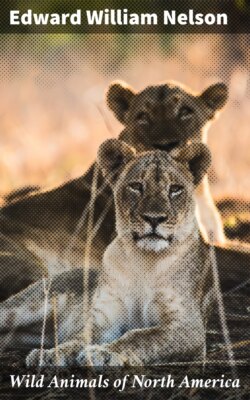Читать книгу Wild Animals of North America - Edward William Nelson - Страница 22
На сайте Литреса книга снята с продажи.
MOUNTAIN LION (Felis couguar and its subspecies)
ОглавлениеTable of Contents
The mountain lion, next to the jaguar, is the largest of the cat tribe native to America. In various parts of its range it is also known as the panther, cougar, and puma. It is a slender-bodied animal with a small head and a long round tail, with a total length varying from seven to nine feet and a weight from about 150 to 200 pounds.
It has from two to five young, which are paler brown than the adult and plainly marked with large dusky spots on the body and with dark bars on the tail. These special markings of the young, as in other animals, are ancestral, and here appear to indicate that in the remote past our plain brown panther was a spotted cat somewhat like the leopard.
No other American mammal has a range equal to that of the mountain lion. It originally inhabited both North and South America from southern Quebec and Vancouver Island to Patagonia and from the Atlantic to the Pacific coasts. Within this enormous territory it appears to be equally at home in an extraordinary variety of conditions. Formerly it was rather common in the Adirondacks of northern New York and still lives in the high Rocky Mountains of the West, where it endures the rigors of the severest winter temperatures. It is generally distributed, where large game occurs, in the treeless ranges of the most arid parts of the southwestern deserts, and is also well known in the most humid tropical forests of Central and South America, whose gloomy depths are drenched by almost continual rain.
A number of geographic races of the species have been developed by the varied character of its haunts. These are usually characterized by differences in size and by paler and grayer shades in the arid regions and by darker and browner ones in the humid areas.
The mountain lion, while powerful enough to be dangerous to man, is in reality extremely timid. Owing to its being a potentially dangerous animal, the popular conception of it is that of a fearsome beast, whose savage exploits are celebrated in the folk-lore of our frontier. As a matter of fact, few wild animals are less dangerous, although there are authentic accounts of wanton attacks upon people, just as there are authentic instances of buck deer and moose becoming aggressive. It has a wild, screaming cry which is thrillingly impressive when the shades of evening are throwing a mysterious gloom over the forests. In the mountains of Arizona one summer a mountain lion repeatedly passed along a series of ledges high above my cabin at dusk, uttering this loud weird cry, popularly supposed to resemble the scream of a terrified woman.
The mountain lion is usually nocturnal, but in regions where it is not hunted it not infrequently goes abroad by day. It is a tireless wanderer, often traveling many miles in a single night, sometimes in search of game and again in search of new hunting grounds. I have repeatedly followed its tracks for long distances along trails, and in northern Chihuahua I once tracked one for a couple of miles from a bare rocky hill straight across the open, grassy plain toward a treeless desert mountain, for which it was heading, some eight or ten miles away.
Although inoffensive as to people, this cat is such a fierce and relentless enemy of large game and live stock that it is everywhere an outlaw. Large bounties on its head have resulted in its extermination in most parts of the eastern United States and have diminished its numbers elsewhere. It is not only hunted with gun and dog but also with trap and poison.
A mountain lion usually secures its prey by a silent, cautious stalk, taking advantage of every cover until within striking distance, and then, with one or more powerful leaps, dashing the victim to the ground with all the stunning impact of its weight. In a beautiful live-oak forest on the mountains of San Luis Potosi I once trailed one of these great cats to the spot where it had killed a deer a short time before, and could plainly read in the trail the story of the admirable skill with which it had moved from cover to cover until it reached a knoll at one side of the little glade where the deer was feeding. Then a great leap carried it to the deer’s back and struck the victim to the ground with such violence that it slid 10 or 12 feet across the sloping ground, apparently having been killed on the instant.
Another trail followed in the snow on the high mountains of New Mexico led to the top of a projecting ledge from which the lion had leaped out and down over 20 feet, landing on the back of a deer and sliding with it 50 feet or more down the snowy slope.
The mountain lion often kills calves, but is especially fond of young horses. In many range districts of the Western States and on the table-land of Mexico, owing to the depredations of this animal, it is impossible to raise horses. Unfortunately the predatory habits of this splendid cat are such that it can not continue to occupy the same territory as civilized man and so is destined to disappear before him.
